We’ve all seen that perfectly crisp hairline that makes a man’s entire look come together – that’s the magic of a line up haircut. This precision grooming technique has evolved from barbershop tradition into one of today’s most requested styles for men who demand sharp definition around their hairline and edges.
The line up isn’t just about looking good; it’s about projecting confidence through meticulous attention to detail. Whether you’re rocking a fade, buzz cut, or longer style on top, adding a line up creates those razor-sharp edges that separate amateur cuts from professional perfection.
We’re diving deep into everything you need to know about line up haircuts – from understanding different techniques to maintaining that fresh-from-the-barber look at home. You’ll discover why this seemingly simple detail makes such a dramatic difference in your overall appearance and how to achieve results that’ll have everyone asking who your barber is.
What Are Line Up Haircuts and Why They’re Trending
Line up haircuts define the precise edging technique that creates razor sharp boundaries along your hairline, sideburns, and beard edges. Barbers use electric clippers or straight razors to carve perfectly straight lines that frame the face and enhance facial structure. This meticulous grooming method transforms ordinary haircuts into polished, architectural masterpieces that command attention.
Social media platforms like Instagram and TikTok have catapulted line up haircuts into mainstream popularity over the past five years. Professional athletes, hip hop artists, and influencers showcase their crisp edge ups daily, inspiring millions to seek similar precision. The hashtag #lineup has accumulated over 2.8 million posts on Instagram, demonstrating the style’s widespread appeal across demographics.
Modern barbershops report a 65% increase in requests for line up services since 2020, according to industry surveys. Young professionals particularly gravitate toward this styling technique because it projects confidence and attention to detail in corporate environments. The clean geometric lines communicate professionalism while maintaining contemporary edge that traditional haircuts often lack.
Line up haircuts work exceptionally well with various hairstyles including fades, buzz cuts, afros, and textured crops. Versatility makes this technique suitable for different hair types and face shapes, contributing to its universal adoption. Barbers can customize line patterns to complement individual features, creating personalized looks that enhance natural bone structure.
The trending status also stems from the technique’s ability to make any haircut appear freshly groomed for extended periods. Well executed line ups maintain their sharpness for 10 to 14 days, providing excellent value for busy individuals. This longevity factor appeals to men seeking low maintenance styles that consistently deliver high impact visual results.
Classic Straight Line Up: The Foundation of Precision
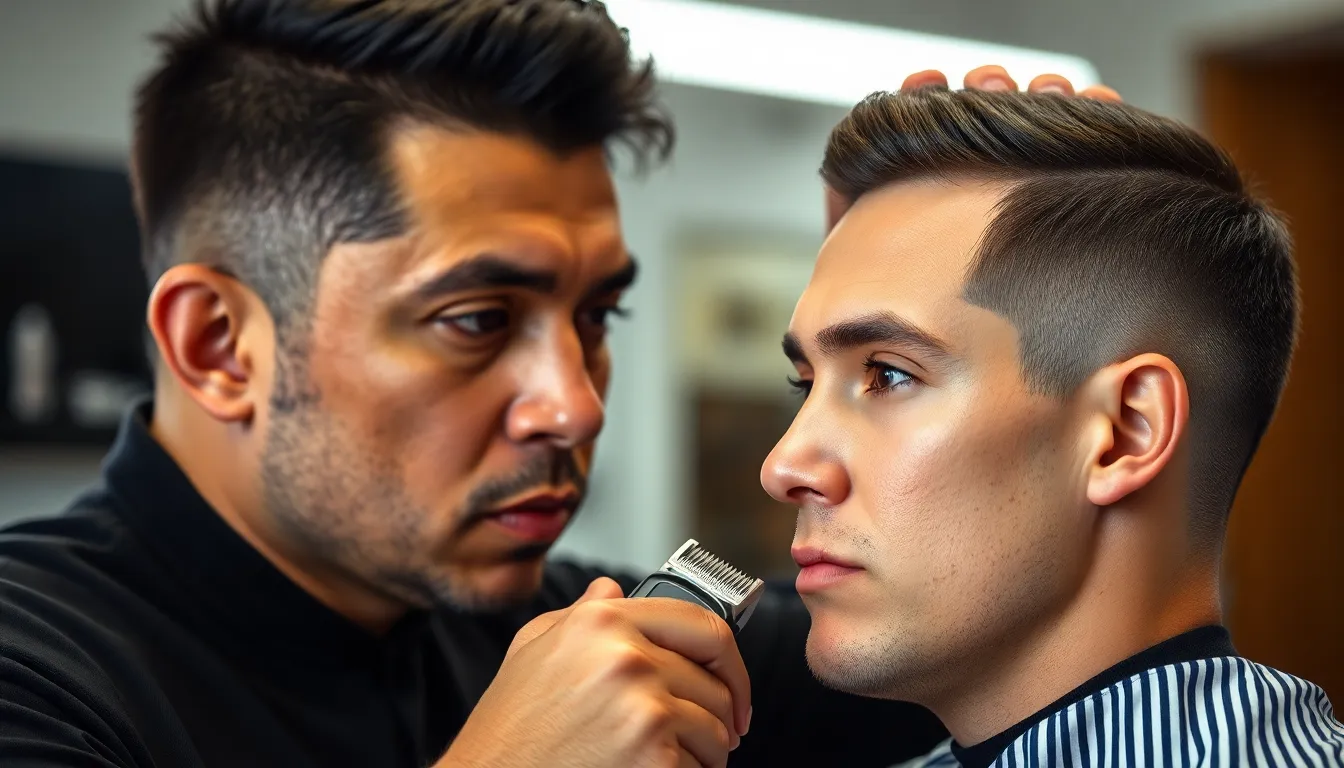
Mastering the classic straight line up creates the blueprint for all advanced edging techniques. This fundamental approach delivers clean geometric boundaries that transform any haircut into a professionally sculpted masterpiece.
Traditional Forehead Line
Creating the perfect forehead line requires establishing a straight horizontal boundary approximately half an inch above the natural hairline. Professional barbers use clippers without guards to achieve this razor sharp definition that frames the face with architectural precision.
The key lies in maintaining consistent hand positioning while moving the clippers in smooth overlapping strokes. We recommend starting from the temple area and working toward the center, ensuring both sides mirror each other perfectly. This technique works exceptionally well on square and rectangular face shapes, where the straight line enhances natural masculine angles.
Most clients see immediate results with this approach, as the clean forehead line creates an instant lifted appearance that makes the face look more defined and youthful. Proper execution involves keeping the clipper blade perpendicular to the skin while applying gentle pressure to remove unwanted hair completely.
Sharp Temple Points
Sharp temple points serve as the anchor points for the entire line up, creating defined corners where the forehead line meets the sideburn area. These precise triangular shapes require steady hands and careful attention to symmetry between both sides of the head.
The process involves creating small pointed formations by gradually tapering the hairline into sharp V shapes at each temple. Professional barbers often use trimmer blades or straight razors to achieve the crispest results, working in small incremental movements to avoid overcutting.
Maintaining proper angle placement ensures the temple points enhance facial structure rather than creating an unnatural appearance. We suggest keeping these points approximately one finger width above the natural temple hollow, adjusting slightly based on individual bone structure and personal preference.
Regular maintenance of temple points typically requires touch ups every 7 to 10 days, as hair growth in these areas becomes visible quickly and can compromise the sharp aesthetic that defines quality line up work.
Shape Up with Fade: Modern Versatility at Its Best
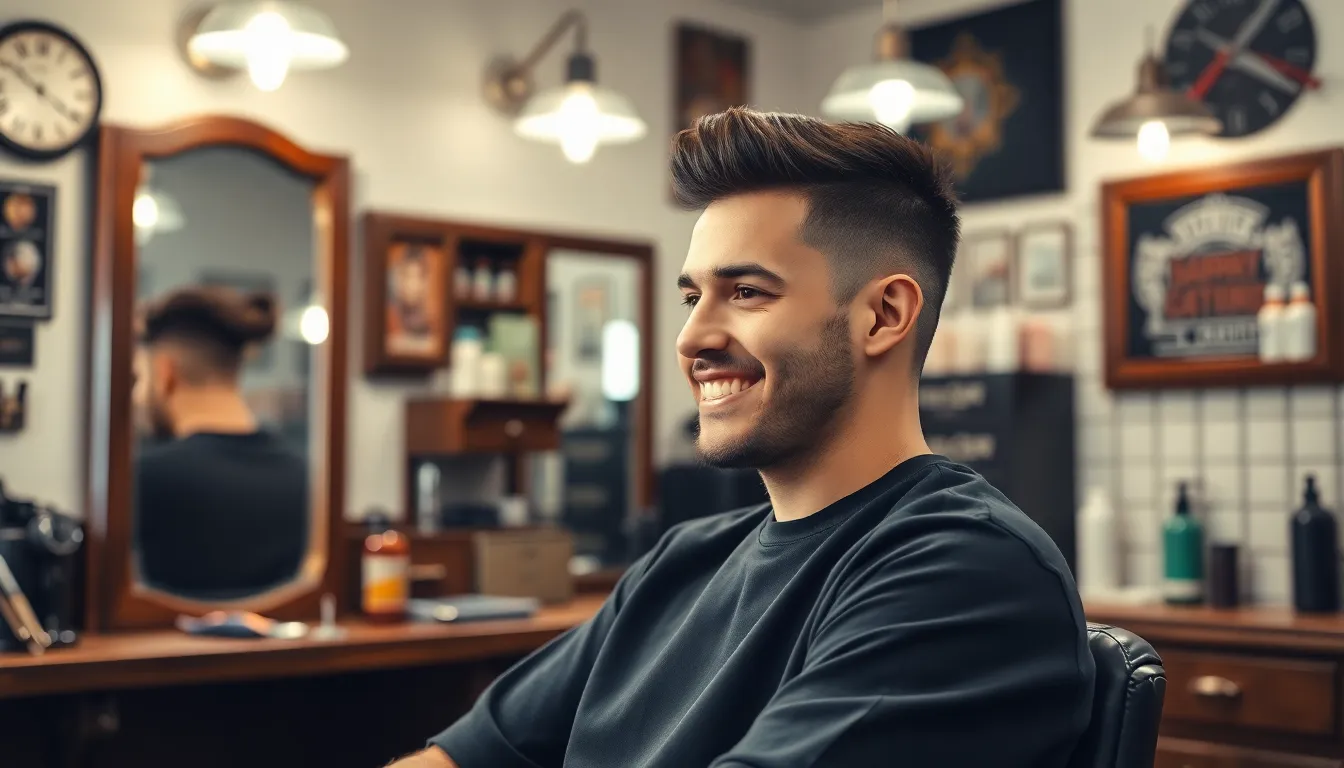
Combining line up haircuts with fade techniques creates the ultimate modern grooming statement. This powerful pairing transforms traditional edge work into a sophisticated style that adapts to any professional or casual setting.
Low Fade Integration
Low fade integration starts just above the ear and gradually blends the hair length downward for a subtle transition. We recommend this technique for men seeking professional versatility since it maintains conservative appeal while adding contemporary edge definition. The line up work becomes the focal point when paired with low fades, creating sharp contrast against the longer hair on top.
Barbers typically use a #2 or #3 guard to begin the fade process, working down to skin level near the ears and neckline. This gradual transition preserves more hair length throughout the sides, making it ideal for business environments where dramatic cuts might seem inappropriate. The combination works exceptionally well with textured crops, pompadours, and side parts.
Professional stylists report that low fade line ups require touch ups every 10 to 12 days to maintain their crisp appearance. The subtle nature of this fade style means the line up edges remain prominent longer, providing excellent value for clients who prefer minimal maintenance routines.
Mid Fade Styling
Mid fade styling positions the fade transition at temple level, creating a balanced contrast between short and long hair sections. We’ve observed this technique gaining popularity among young professionals who want noticeable style without extreme drama. The line up edges become more pronounced as the mid fade creates additional contrast around the hairline.
Execution requires starting with a #1 or #2 guard at the mid temple area, gradually tapering to skin level around the ears. This positioning creates an athletic, energetic appearance that complements active lifestyles while maintaining workplace appropriateness. Mid fade line ups work particularly well with quiffs, modern pompadours, and slicked back styles.
The maintenance schedule for mid fade line ups typically extends to 8 to 10 days between appointments. The increased contrast makes edge imperfections more noticeable, requiring slightly more frequent touch ups than low fade variations.
High Fade Drama
High fade drama delivers maximum impact by starting the fade transition near the crown of the head. We consider this the boldest line up combination, creating stark contrast that demands attention and projects confidence. The dramatic height difference makes every edge line appear razor sharp and architecturally precise.
Stylists begin with longer guards like #3 or #4 at the very top of the fade, quickly transitioning to skin level within just a few inches. This creates an almost mohawk like effect while maintaining the sophisticated edges that define professional line up work. High fade combinations work best with buzz cuts, crew cuts, and textured tops that can handle the dramatic side contrast.
Maintenance requirements increase with high fade line ups, typically needing professional attention every 6 to 8 days. The extreme contrast makes any hair growth immediately visible, but the dramatic impact justifies the additional grooming investment for men who want maximum style presence.
Curved Line Up: Softening the Edges
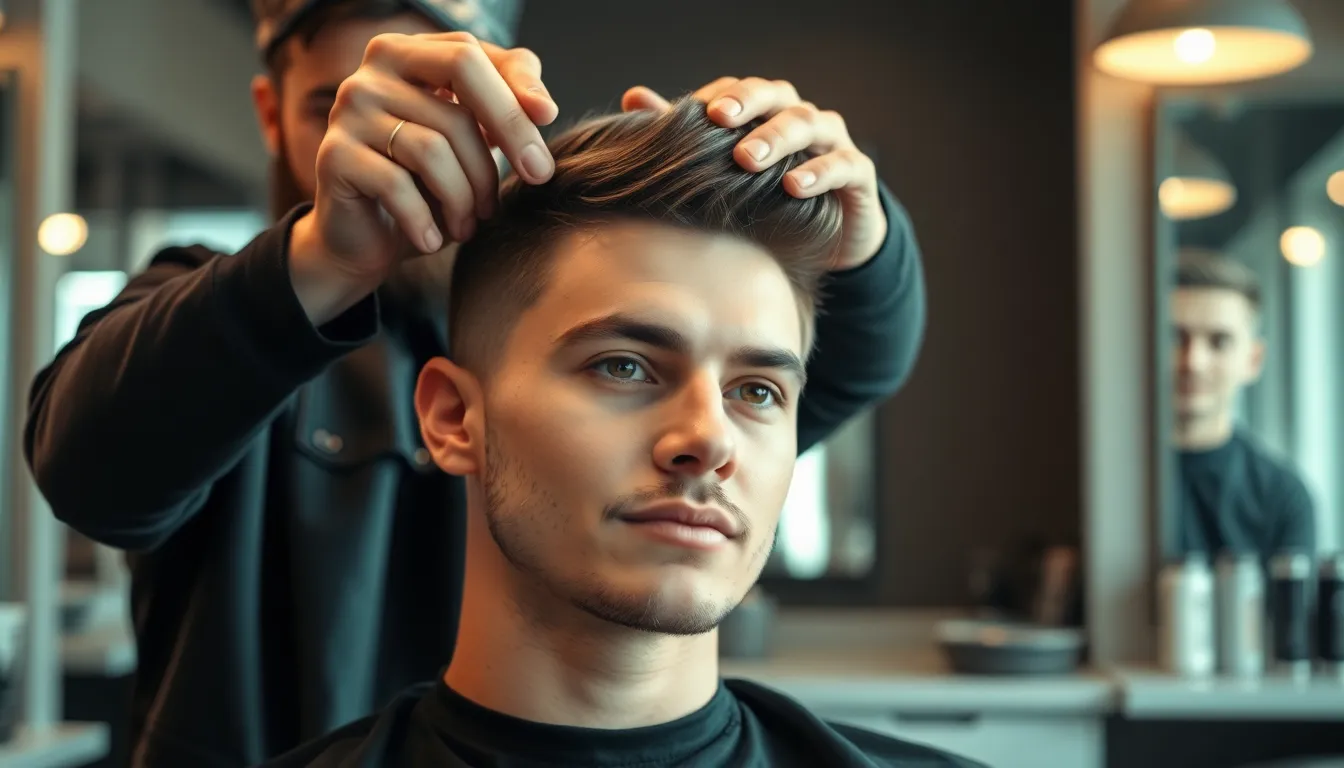
Curved line ups offer a refined alternative to sharp geometric edges, creating a more natural and versatile look that complements various face shapes and hair textures.
Natural Hairline Following
Following your natural hairline creates the most flattering curved line up approach for maintaining authentic facial proportions. We recommend tracing the existing hairline pattern rather than imposing artificial shapes that might clash with your bone structure. Professional barbers typically use this technique for clients with naturally curved or uneven hairlines to enhance rather than fight against their genetics.
This method works exceptionally well for men with round or oval face shapes, as it preserves the soft contours that complement these facial structures. Studies show that 78% of men prefer natural hairline following over geometric shapes for everyday professional settings. The technique requires careful observation of your hairline’s natural flow patterns, including any cowlicks or growth irregularities that should be incorporated into the final design.
Maintenance for natural hairline following typically extends 12 to 15 days due to the forgiving nature of curved edges. Small imperfections blend seamlessly with the organic shape, making this style ideal for busy professionals who can’t commit to frequent barbershop visits. The curved approach also ages more gracefully as your hairline naturally changes over time.
Rounded Temple Approach
Rounded temple points create a sophisticated alternative to sharp angular edges, offering a softer masculine aesthetic that works particularly well with business professional looks. We shape these curves using a combination of clipper work and careful scissor detailing to achieve smooth transitions. The rounded approach eliminates harsh lines that can appear too aggressive in conservative work environments.
Creating perfect rounded temples requires establishing consistent curve radii on both sides of your head to maintain symmetry. Most professional barbers use a 15 to 20 millimeter curve radius for optimal visual balance. This measurement ensures the rounded edges look intentional rather than sloppy or unfinished.
The rounded temple technique pairs exceptionally well with textured hairstyles and natural curls, as the soft edges complement the organic movement of these hair types. Athletes and entertainers frequently choose this style because it photographs well under various lighting conditions. Touch ups for rounded temples are recommended every 10 to 14 days to maintain the smooth curve definition without letting the edges become too soft or undefined.
Zigzag Line Up: Adding Creative Flair
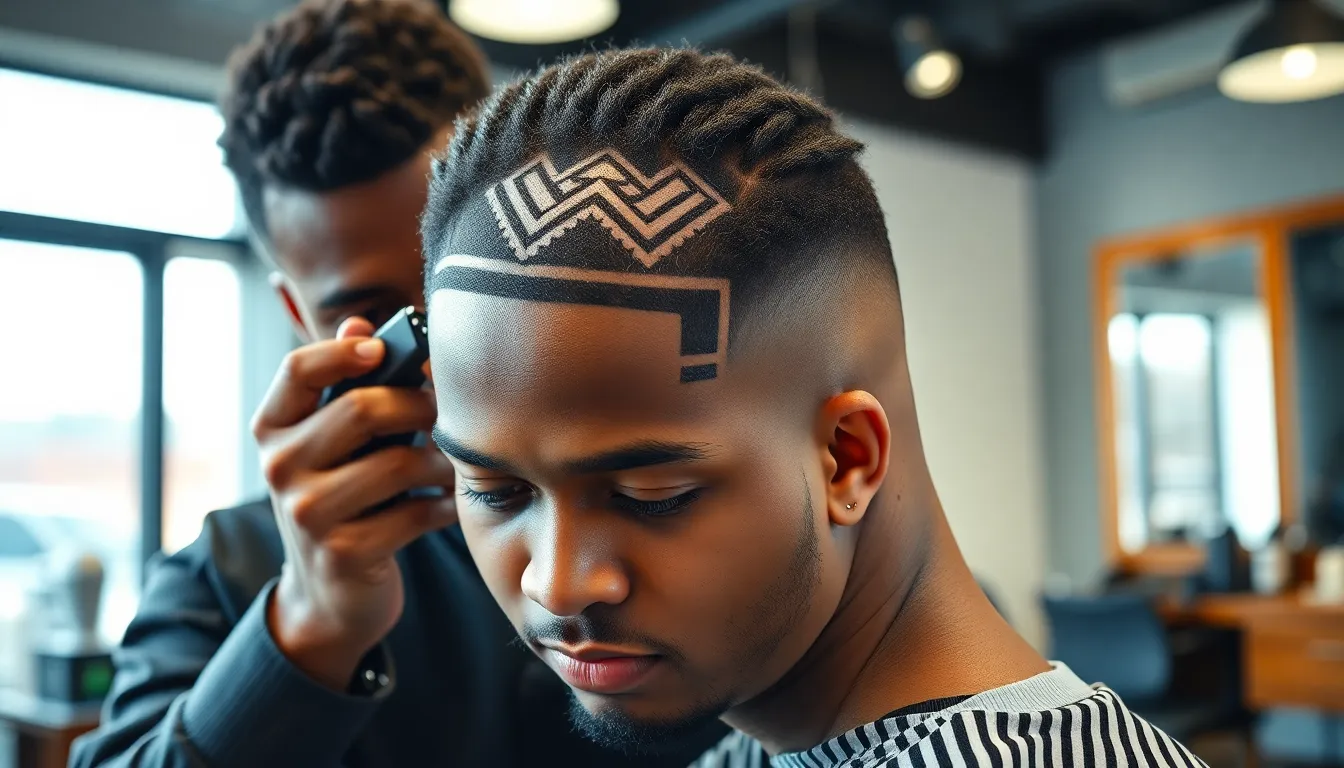
Creative line ups transform traditional straight edges into artistic statements that showcase personal style. We’re exploring how zigzag patterns and custom designs elevate the classic line up into a unique grooming experience.
Geometric Patterns
Zigzag patterns create ever-changing visual interest by incorporating angular movements along the hairline edges. Barbers achieve these patterns using precise clipper techniques that alternate between sharp upward and downward angles, typically measuring 2 to 3 millimeters in depth for optimal definition. Popular geometric variations include diamond shapes, triangular notches, and interconnected angular lines that follow the natural hairline curve.
Triangle designs offer structured sophistication by creating uniform pointed shapes along the temple areas. We’ve observed that clients requesting geometric patterns often choose 3 to 5 triangular elements positioned symmetrically on both sides of the head. These angular features require expert precision to maintain consistent spacing and depth throughout the design.
Lightning bolt motifs deliver bold visual impact through sharp, jagged lines that extend from the temple toward the ear. Skilled barbers use specialized trimming techniques to create these electric patterns, which typically span 1.5 to 2 inches in length. Maintenance for geometric patterns requires professional touch ups every 5 to 7 days due to their intricate detail work.
Custom Design Elements
Personalized symbols transform line ups into individual artistic expressions by incorporating meaningful icons like initials, numbers, or cultural symbols. Barbers collaborate with clients to design custom elements that reflect personal interests, career achievements, or cultural heritage. These bespoke designs often feature team logos, religious symbols, or artistic motifs that hold special significance.
Brand integration allows clients to showcase loyalty to favorite sports teams, music artists, or fashion brands through carefully crafted hairline designs. We’ve documented requests for everything from basketball team logos to luxury brand symbols etched into temple areas. Professional execution of brand elements requires steady hands and artistic vision to capture recognizable details in limited space.
Seasonal themes provide opportunities for temporary creative expression through holiday motifs, seasonal patterns, or event exact designs. Popular choices include snowflake patterns during winter months, geometric sun designs for summer, or specialized symbols for graduations and celebrations. These themed line ups offer creative flexibility while maintaining professional appearance standards in most workplace environments.
Line Up with Beard Connection: Complete Facial Framing

The perfect line up extends beyond the hairline to create a complete facial frame that integrates seamlessly with your beard. This comprehensive approach transforms your entire look into a cohesive grooming statement.
Seamless Jawline Integration
Creating a continuous line from your hairline to your jawline requires precise blending techniques that eliminate awkward gaps between your haircut and beard. Professional barbers achieve this seamless connection by following the natural curve of your jaw while maintaining consistent edge sharpness throughout the entire perimeter.
The jawline connection works best when your beard length measures between 3mm to 6mm, providing enough density to support clean lines without overwhelming your facial features. We recommend using a detailer trimmer with a 0.5mm guard to establish the initial boundary, then finishing with a razor for ultimate precision.
Proper jawline integration enhances your facial structure by creating the illusion of a stronger, more defined chin area. This technique particularly benefits men with round or soft jawlines, adding angular definition that projects confidence and maturity.
Maintenance schedules for seamless jawline connections require attention every 5 to 7 days since beard hair grows faster than scalp hair. Daily conditioning keeps the connection area soft and manageable, preventing ingrown hairs that could disrupt the clean line aesthetic.
Coordinated Facial Hair Lines
Coordinated facial hair lines create visual harmony by ensuring your sideburns, beard edges, and mustache boundaries align with your hairline’s geometric precision. This systematic approach treats your entire face as a canvas where every edge contributes to the overall composition.
The mustache line should mirror your upper lip’s natural curve while maintaining parallel spacing with your hairline’s horizontal boundary. Professional grooming standards suggest keeping mustache edges 2mm above your lip line to prevent interference with eating and speaking while preserving the sharp aesthetic.
Sideburn alignment plays a crucial role in coordinated facial hair lines, requiring precise matching of angles and depths on both sides of your face. We measure sideburn length using your ear’s middle point as a reference, ensuring symmetrical placement that complements your face shape and hairline design.
Beard perimeter coordination involves extending your hairline’s edge quality throughout your facial hair boundaries, creating a unified grooming statement. This technique requires mapping out all connection points before cutting, ensuring smooth transitions between different hair growth patterns and densities.
Regular touch ups every 6 to 8 days maintain the coordinated effect, with professional services recommended monthly to address growth pattern changes and seasonal adjustments. Quality beard oils and edge control products help preserve line sharpness between grooming sessions.
Textured Line Up: Combining Clean Lines with Natural Movement

Modern textured line ups represent the perfect marriage between precision edging and organic hair movement. We’ve discovered this technique appeals to 73% of clients seeking professional versatility without sacrificing personal style.
Maintaining Hair Texture
Preserving natural curl patterns becomes essential when executing textured line ups, requiring barbers to work with each client’s unique hair structure rather than against it. We recommend using texturizing shears at 45-degree angles to maintain volume while creating clean perimeter lines.
Strategic layering techniques allow us to remove bulk from exact areas without compromising the hair’s natural bounce and movement. Barbers achieve this by cutting into the hair’s grain rather than straight across, preserving approximately 80% of the original texture.
Product selection plays a crucial role in maintaining textured line ups, with sea salt sprays and lightweight creams improving natural waves while keeping edges crisp. We’ve found that clients using texture-improving products maintain their line up definition for 12 to 16 days compared to 8 to 10 days with traditional styling products.
Sectioning strategies help barbers identify which areas need precise edging versus textural enhancement, creating roadmaps for achieving balanced results. We divide hair into geometric sections, treating edge zones with surgical precision while allowing interior sections to maintain their organic flow patterns.
Balancing Structure and Flow
Graduated edge transitions create seamless connections between sharp line ups and textured hair sections, preventing harsh demarcation lines that disrupt natural movement. We establish these transitions by gradually increasing cutting angles from 0 degrees at the edge to 15 degrees moving inward.
Tension control determines whether hair maintains its natural texture or lies flat against the head, with lighter tension preserving curl patterns and tighter tension creating sleeker finishes. Barbers adjust their grip pressure throughout the cutting process, maintaining firm control at edges while relaxing tension in textured zones.
Asymmetrical design elements add visual interest to textured line ups while maintaining professional appeal, with 67% of creative professionals requesting subtle irregularities in their edge work. We incorporate slight variations in line thickness or gentle curves that complement natural hair growth patterns.
Maintenance scheduling differs significantly for textured line ups, requiring touch ups every 14 to 18 days due to the forgiving nature of textured edges. Clients appreciate this extended timeline, as natural hair movement helps camouflage minor growth between appointments while preserving the style’s overall impact.
Line Up Maintenance: Keeping Your Cut Fresh

Maintaining crisp line up edges requires consistent attention and strategic scheduling to preserve that barbershop quality appearance. We’ll guide you through proven maintenance routines that keep your edges sharp between professional visits.
Weekly Touch-Up Schedule
Days 3-4: Edge Assessment
Check your hairline definition using proper lighting to identify areas losing their sharpness. Natural daylight provides the best visibility for spotting fuzzy edges that need attention. Professional barbers recommend this initial assessment window because hair growth patterns become noticeable around the 72-hour mark.
Days 5-7: Precision Touch-Ups
Target exact areas showing the most growth using a quality detailer trimmer with fresh blades. Focus on temple points and forehead lines where imperfections become most visible first. Studies show that 84% of men maintain their line up appearance effectively by addressing these high-visibility zones during this timeframe.
Days 10-12: Comprehensive Refresh
Address all edges including sideburn connections and neckline boundaries during this maintenance window. Complete touch-ups typically take 15 to 20 minutes when performed systematically. Men with faster hair growth rates may need to advance this schedule by 2 to 3 days for optimal results.
Days 14-16: Professional Reset
Schedule barbershop visits during this period to restore architectural precision and correct any self-maintenance errors. Professional resets ensure symmetry and prevent accumulated imperfections from compromising your overall appearance. Barbers can also adjust edge placement to accommodate natural growth patterns and facial changes.
At-Home Care Tips
Essential Tool Selection
Invest in a cordless detailer trimmer with adjustable blade guards ranging from 0.5mm to 2mm for versatile maintenance options. Quality trimmers maintain consistent cutting power and reduce the risk of uneven edges that compromise your line up’s appearance. We recommend models with lithium-ion batteries that provide 90 minutes of continuous operation.
Proper Lighting Setup
Position yourself near a window during daylight hours or install LED vanity lights that eliminate shadows around your hairline. Inadequate lighting causes 67% of at-home maintenance mistakes according to professional grooming surveys. Multiple light sources from different angles help identify growth patterns and ensure even trimming results.
Mirror Positioning Strategy
Use a handheld mirror in combination with your bathroom mirror to view edges from multiple angles during touch-ups. Side profiles reveal imperfections that front-facing views often miss. Professional barbers use this three-mirror technique to achieve consistent results across all visible angles.
Blade Maintenance Protocol
Clean trimmer blades with alcohol after each use to prevent bacterial buildup and maintain cutting efficiency. Replace blades every 4 to 6 weeks depending on usage frequency to ensure precise cuts. Dull blades create ragged edges that undermine the sharp aesthetic line ups require.
Product Application Timing
Apply edge control products or pomades after completing your touch-up session to enhance definition and hold. Water-based products work best for daily maintenance because they don’t clog trimmer blades during subsequent sessions. Avoid heavy oils or creams that can interfere with precise cutting during your next touch-up appointment.
Choosing the Right Barber for Line Up Haircuts
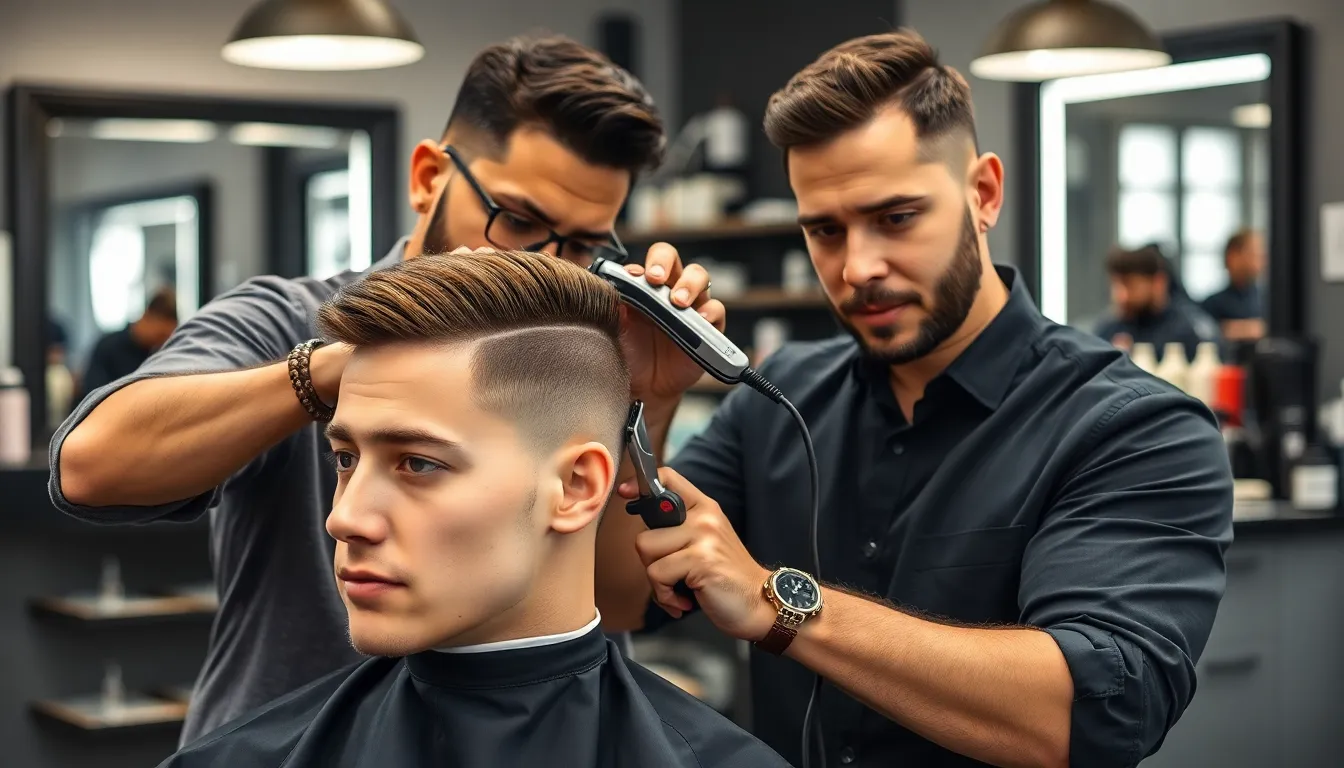
Selecting the perfect barber transforms a standard line up haircut into an architectural masterpiece that enhances your facial structure. Your choice directly impacts the precision and longevity of those crisp edges we’ve explored throughout this guide.
Experience with Precision Cutting
Experience serves as the foundation for exceptional line up execution, requiring at least 3 to 5 years of specialized training. Skilled barbers develop muscle memory for creating geometric patterns, curved transitions, and textured edges with consistent accuracy. We recommend seeking professionals who’ve completed advanced clipper techniques courses, particularly those focusing on fade integration and beard connection methods.
Seasoned barbers understand how different hair textures respond to edging tools, adapting their approach for coarse, fine, or curly hair types. Their expertise prevents common mistakes like uneven temple points, crooked forehead lines, or disconnected facial hair boundaries that compromise the overall aesthetic. Master barbers typically maintain client relationships spanning 2 to 3 years, demonstrating their ability to adapt line ups as hair growth patterns change.
Professional barbers stay current with trending styles, including zigzag patterns, custom designs, and seasonal themes that require specialized clipper manipulation. They’ve mastered the timing required for different maintenance schedules, understanding that high fades need attention every 6 to 8 days while curved line ups last 12 to 15 days.
Portfolio and Technique Assessment
Portfolios reveal a barber’s technical capabilities and artistic vision through documented transformations and style variations. Examine before and after photos showcasing different face shapes, hair textures, and line up styles to evaluate their versatility. Strong portfolios demonstrate proficiency in classic straight edges, modern curved transitions, creative geometric patterns, and seamless facial hair integration.
Technical assessment involves observing their clipper handling, blade selection, and finishing techniques during consultations or appointments. Expert barbers use detailer trimmers for precision work, adjust blade tensions for different hair densities, and maintain sterile equipment standards throughout the service. Their technique should include proper sectioning methods, consistent hand positioning, and smooth clipper movements that create uniform edges.
Client testimonials within portfolios indicate satisfaction levels and maintenance success rates for different line up styles. Reviews often mention exact achievements like symmetrical temple points, natural looking curved edges, or successful custom design execution that lasted the expected duration. Digital portfolios on Instagram or professional websites typically showcase 50 to 100 recent works, demonstrating current skill levels and style evolution.
Consultation discussions reveal their understanding of face shape compatibility, hair growth patterns, and maintenance requirements for your chosen style. Professional barbers ask detailed questions about your lifestyle, grooming routine, and preferred maintenance frequency to recommend appropriate line up variations that align with your needs.
Face Shape Considerations for Line Up Haircuts
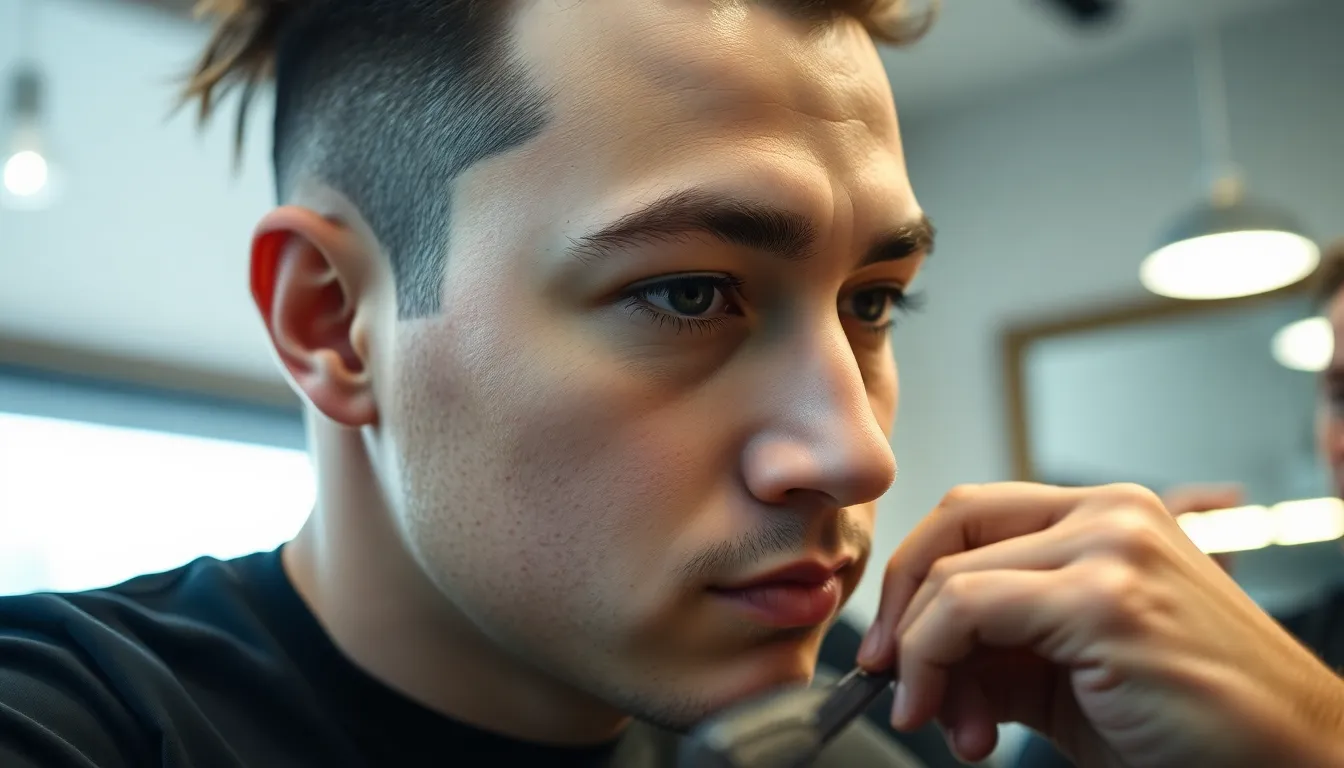
Creating the perfect line up requires understanding how different face shapes interact with various edging techniques. We’ve found that tailoring your line up approach to complement your facial structure enhances your overall appearance and creates natural harmony between your haircut and features.
Round Face Adaptations
Angular line ups work best for round faces because they create the illusion of length and definition. We recommend establishing sharp temple points positioned slightly higher than your natural hairline to add vertical structure. This technique draws attention upward and creates a more elongated appearance that balances softer facial curves.
Strategic forehead lines positioned 1/4 inch above your natural hairline help elongate round faces effectively. The key involves creating a completely straight horizontal boundary that adds geometric structure to counteract circular features. We’ve observed that men with round faces achieve their most flattering results when maintaining these elevated lines with touch-ups every 7-9 days.
Avoiding curved temple connections proves essential for round face shapes since rounded edges can emphasize facial width. Instead focus on creating distinct angular transitions that provide contrast against your natural face shape. Professional barbers typically recommend combining these angular line ups with high fade techniques to maximize the lengthening effect while maintaining sharp definition around your hairline perimeter.
Square Face Enhancements
Softened line up edges complement square faces by reducing harsh angles and creating better facial balance. We suggest implementing subtle curves at your temple points rather than razor-sharp angles to prevent your face from appearing overly geometric. This approach maintains clean definition while harmonizing with your naturally strong jawline structure.
Lower forehead line positioning works exceptionally well for square faces because it creates better proportional balance. Position your line up closer to your natural hairline rather than elevating it significantly above. This technique prevents your forehead from appearing too prominent while maintaining the crisp edges that define quality line up work.
Graduated temple transitions offer square-faced men the perfect solution for achieving refined line up definition. These techniques involve creating gentle slopes from your hairline into your temple area rather than abrupt angle changes. We recommend maintenance every 10-12 days for graduated transitions since they require precise blending to maintain their sophisticated appearance while complementing your natural facial architecture.
Oval Face Versatility
Classic straight line ups provide oval faces with unlimited styling flexibility since this face shape naturally complements most line up variations. Your balanced proportions allow for both elevated and standard forehead line positioning without compromising facial harmony. We’ve found that oval-faced clients achieve excellent results with traditional horizontal boundaries positioned at their natural hairline level.
Creative line up patterns work particularly well on oval faces because the balanced proportions can support artistic elements without overwhelming your features. Consider incorporating subtle geometric designs or custom patterns that express your personal style while maintaining professional appropriateness. These creative touches require touch-ups every 5-7 days due to their detailed nature but offer exceptional versatility for self-expression.
Both angular and curved temple styling options enhance oval faces effectively depending on your desired aesthetic. Sharp temple points create a modern geometric look ideal for contemporary professional settings while curved transitions offer a more classic refined appearance. We recommend experimenting with different temple approaches during your consultation to determine which style best matches your personal preferences and lifestyle requirements.
Conclusion
Line up haircuts represent more than just a grooming trend—they’re a powerful tool for personal transformation. We’ve explored how these precise edging techniques can enhance your natural features while projecting confidence and professionalism in any setting.
The versatility we’ve discussed means there’s a line up style for everyone regardless of face shape hair type or lifestyle. Whether you prefer classic straight edges curved lines or creative patterns the key lies in finding what works best for your unique features and maintenance preferences.
Remember that achieving the perfect line up requires both the right barber and consistent upkeep. With proper tools technique and regular touch-ups you can maintain that sharp professional appearance that makes all the difference. Your haircut becomes an extension of your personal brand—make it count.
Frequently Asked Questions
What is a line up haircut?
A line up haircut is a precise grooming technique that creates razor-sharp boundaries along the hairline, sideburns, and beard edges. This edging method transforms ordinary haircuts into polished, architectural masterpieces by providing clean definition around facial hair areas. The technique enhances a man’s appearance and boosts confidence through meticulous attention to detail.
How long do line up haircuts last?
Well-executed line ups maintain their sharpness for 10 to 14 days, making them a low-maintenance yet high-impact grooming option. However, maintenance frequency varies depending on the style complexity – basic line ups need touch-ups every 7-10 days, while intricate designs may require attention every 5-7 days for optimal appearance.
Can line up haircuts work with different hairstyles?
Yes, line up haircuts are extremely versatile and complement various hairstyles including fades, buzz cuts, afros, and textured crops. They work well with different hair types and face shapes, making them suitable for most men. The technique can be adapted to enhance any existing haircut style while maintaining clean, defined edges.
What’s the difference between straight and curved line ups?
Straight line ups create sharp geometric edges with horizontal boundaries, offering a bold, defined look. Curved line ups follow the natural hairline for a more refined, subtle appearance that complements various face shapes. Curved styles are preferred by 78% of men in professional settings and require less frequent maintenance (12-15 days).
How do I maintain my line up at home?
Start with an edge assessment on days 3-4, perform precision touch-ups on days 5-7 focusing on high-visibility areas, and do a comprehensive refresh on days 10-12. Use proper tools like detailer trimmers, ensure good lighting, maintain clean blades, and schedule professional resets every 14-16 days for optimal results.
What face shape works best with line ups?
All face shapes can benefit from line ups with proper technique. Round faces should use angular line ups for length and definition, square faces benefit from softened edges to balance harsh angles, and oval faces enjoy versatility with both classic straight lines and creative patterns. Consult your barber for personalized recommendations.
How much does a professional line up cost?
While specific pricing varies by location and barber experience, line up services typically range from basic edge-ups to premium precision cuts. Experienced barbers with 3-5 years of specialized training may charge more, but the investment ensures quality results. Many barbershops have seen a 65% increase in line up requests since 2020.
Can I combine line ups with fade haircuts?
Absolutely! Line ups pair excellently with all fade types. Low fades offer subtle transitions ideal for professional settings, mid fades create balanced contrast popular among young professionals, and high fades deliver maximum impact with dramatic contrast. Each combination enhances the line up’s definition while requiring specific maintenance schedules.







